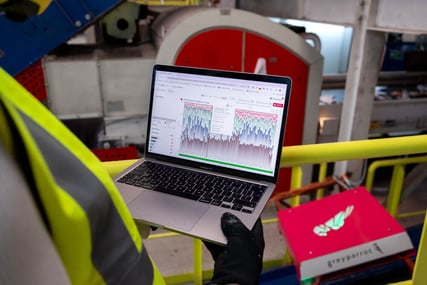This article is part of our series on waste intelligence.
The first system for solid waste management took shape in late 18th-century London, when waste workers began to manually collect and recycle discarded material in the city’s dust yards.
Facilities grew alongside swelling waste flows, and recycling innovators applied machinery like collections vehicles and conveyor belts to process more material. Only in the last few decades have tools like optical sorters, mechanical balers, and air jet separators introduced automation to materials recovery facilities (MRFs), helping them keep pace with the rising tide of waste.
Today, a spike in global consumption means we’re throwing away more recyclable material than current manual or mechanical systems can effectively recover: by 2050, we’ll be producing 3.8 billion tonnes of municipal solid waste a year.
How big is the waste data gap?
Technology has streamlined everything from sorting to baling, but until now, facility operators have relied on manual counting to gather waste data. The average recovery facility measures just 1% of the waste it receives, but no two waste streams are the same. To add to that challenge, MRFs are expected to process more mixed materials each year.
Plastic alone now accounts for 350 million tonnes of waste material annually, yet only 15% of it is recovered due to a lack of visibility and automation. As the saying goes, "You can't manage what you don't measure."
How does AI waste analytics unlock real-time data on waste material?
AI waste analytics systems like Greyparrot Analyzer combine computer vision with automated data analysis, delivering real-time data on waste flows at scale.
These systems significantly enhance visibility into waste streams, automatically gathering and analyzing waste composition at a rate 62 times faster than manual counting. Additionally, retrofits can be completed within 1-2 hours, without needing new, costly infrastructure.
The magnitude of AI's impact is clear: our systems analysed over 25 billion waste objects in 2023 alone, a number that increases exponentially with each new Analyzer deployment.

What is waste intelligence?
If we think of AI waste analytics as the tool responsible for collecting and organising vast amounts of waste data, then the concept of waste intelligence naturally emerges as the outcome of adopting data-driven strategies.
💡 Waste intelligence is the actionable insight gathered from detailed waste data, used to minimise waste and optimise resource use.
In other words, waste intelligence is the process of translating waste data into tangible action. That action translates into resource efficiency across the entire value chain.
By leveraging waste intelligence, operators can adjust their operations to respond to changes in material composition. This empowers them to extract more value from waste streams while reducing landfill waste. For instance:
- Operators can find the optimal balance between the amount of waste processed and the recoverable material lost to inefficient sorting.
- They can source higher-quality material and tailor sorting processes to specific suppliers.
- They can proactively maintain hardware based on historical downtime trends, among other strategies.
What does waste intelligence look like in practice?

Plant managers in more than 20 countries are using waste intelligence insights to make their operations more efficient. Start here to learn exactly how they translate data into more profitable facilities:
- How AI waste analytics is driving more profitable plastic recovery at global PRFs ♻️
- How a flagship MRF uses live composition data to maintain high product quality standards 📈
- How AI helps a PET recycler improve yield and remain compliant across multiple countries 🌎
Waste intelligence isn't just transforming the way recovery facilities manage their processes and material. Greyparrot Analyzer units now see over 40 billion waste objects every year, building datasets that are pointing the entire value chain in the direction of resource efficiency:
- The world's first waste intelligence platform for brands and packaging producers💡
- Optimising sustainable packaging production with waste intelligence 🏭
- The hidden value lost to landfills and incinerators in 2023 🔍
To learn how waste intelligence is being applied in even more detail, get our free guide to AI for recovery facilities here.

.jpeg?width=780&height=532&name=GreyParrot%20-%20Web%20Quality%20Still-12%20(2).jpeg)


.png?width=501&height=285&name=IMG_6004%20(1).png)